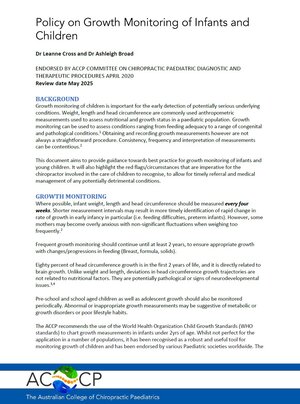| Australian College of Chiropractic Paediatrics |
Policy: Growth Monitoring
Dr Leanne Cross and Dr Ashleigh Broad
ENDORSED BY ACCP COMMITTEE ON CHIROPRACTIC PAEDIATRIC DIAGNOSTIC AND THERAPEUTIC PROCEDURES APRIL 2020
Review date: May 2025
BACKGROUNDGrowth monitoring of children is important for the early detection of potentially serious underlying conditions. Weight, length and head circumference are commonly used anthropometric measurements used to assess nutritional and growth status in a paediatric population. Growth monitoring can be used to assess conditions ranging from feeding adequacy to a range of congenital and pathological conditions.(1) Obtaining and recording growth measurements however are not always a straightforward procedure. Consistency, frequency and interpretation of measurements can be contentious.(2) This document aims to provide guidance towards best practice for growth monitoring of infants and young children. It will also highlight the red flags/circumstances that are imperative for the chiropractor involved in the care of children to recognise, to allow for timely referral and medical management of any potentially detrimental conditions. GROWTH MONITORINGWhere possible, infant weight, length and head circumference should be measured every four weeks. Shorter measurement intervals may result in more timely identification of rapid change in rate of growth in early infancy in particular (i.e. feeding difficulties, preterm infants). However, some mothers may become overly anxious with non-significant fluctuations when weighing too frequently.(2) Frequent growth monitoring should continue until at least 2 years, to ensure appropriate growth with changes/progressions in feeding (Breast, formula, solids). Eighty percent of head circumference growth is in the first 2 years of life, and it is directly related to brain growth. Unlike weight and length, deviations in head circumference growth trajectories are not related to nutritional factors. They are potentially pathological or signs of neurodevelopmental issues.(3,4) Pre-school and school aged children as well as adolescent growth should also be monitored periodically. Abnormal or inappropriate growth measurements may be suggestive of metabolic or growth disorders or poor lifestyle habits. The ACCP recommends the use of the World Health Organization Child Growth Standards (WHO standards) to chart growth measurements in infants under 2 years of age. Whilst not perfect for the application in a number of populations, it has been recognised as a robust and useful tool for monitoring growth of children and has been endorsed by various Paediatric societies worldwide. The WHO charts specifically recognise that breastfeeding is the recommended standard for infant feeding.(5) The WHO growth charts are also available in electronic form. Condition specific growth charts exist, such as for Down Syndrome, achondroplasia, and many other rarer genetic conditions. These growth charts may be used with relevant cases. Chiropractic consultations purely to measure and monitor growth are appropriate if clinically indicated. ROUTINE GROWTH MEASUREMENTS1) Weight Electronic Baby scales up to 20kg should be used. Floor scales can be used from 15kgs. Naked weight (post feeding if possible) is optimal for consistency, especially if there are failure to thrive issues suspected.(2) 2) Length Using an infant Measure mat, from the vertex of the infant’s skull to the heel of the extended leg(s). 3) Head circumference Head circumference tape is placed at the supraorbital ridge and the occipital prominence. Note the measurement to the nearest 0.1cm.(4) 4) Fontanelles Both anterior and posterior fontanels should be assessed Anterior fontanel size is calculated by determining the average of the anteroposterior (a) and the transverse diameter (b).(6) CLINICAL EXPECTATIONS /RECOMMENDATIONSChiropractors involved in the care of young children are expected to: - To record birth weight, length and head circumference and record subsequent growth measurements - Routinely monitor the infant and child’s growth - Record measurements taken contemporaneously - Preferably make use of growth charts, either paper based or electronic to plot and monitor growth from recorded measurements - Be able to use and interpret growth charts and make any necessary referrals or recommendations when indicated. - To make use of growth measurements recorded by other health care practitioners when necessary INDICATIONS FOR INCREASED MONITORING OR REFERRALIt is important to note any changes or deviation from growth trajectories. Should any of the following be present, either in isolation or combination, referral for appropriate medical assessment is recommended: - Weight change that crosses two percentiles over two separate points in time (either rapid growth or loss). - Weight dropping below the second percentile. - Length measurements that plateau. - Weight loss in a child with signs of serious illness. - Cessation or premature halting of head circumference growth - Head circumference change that crosses two percentiles over two separate points in time (either rapid growth or loss). - Head circumference above the 98th percentile or below the 2nd percentile. - Bulging of the anterior fontanel. - Sunken fontanel and additional signs of dehydration. - Failure to close or early closure of the anterior fontanelle or other signs of craniosynostosis. Useful LinksReferences1. Heude B, Scherdel P, and Chalumeau M. Standards or References: A Central Question for Growth Monitoring? 2017 Paediatric and Perinatal Epidemiology, 31, 465–467 2. Sachs M, Dykes F, and Carter B. Weight monitoring of breastfed babies in the UK – centile charts, scales and weighing frequency. 2005 Maternal and Child Nutrition, 1, pp. 63–76 3. Harris SR. Update on infant microcephaly Can Fam Physician. 2015 Aug; 61(8): 680–684. 4. Clinical nursing policy team. "Head Circumference Assessment". Western Australia Child and Adolescent Community Health Manual. 2018;1-5 5. Ziegler EE, Nelson SE. The WHO growth standards: Strengths and limitations. Curr Opin Clin Nutr Metab Care. 2012;15(3):298–302 6. Kiesler J, Ricer R. The abnormal fontanel. Am Fam Physician. 2003;67(12):2547–52. |

